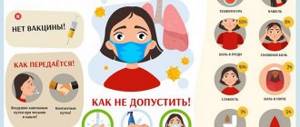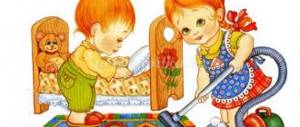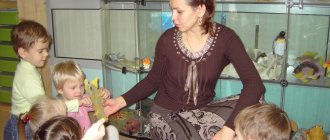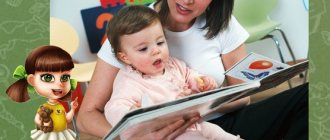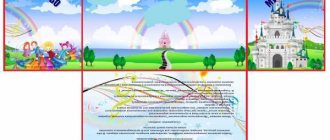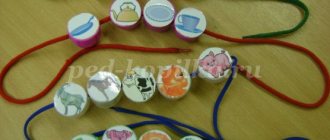Fundamentals of sensory education methods for preschoolers
A child enters preschool age at 3 years old, when he begins to perceive the world with his own eyes. This period of development of a little person’s personality ends before entering the school stage, usually 7 years. This is a fairly long period for a child’s body, so age can be divided conditionally into the following stages:
- junior preschool;
- secondary preschool;
- senior preschool.
In a short period of his life, a child makes a real breakthrough in his psychological development. At this stage of growing up, the baby separates from his parents, he begins to feel and perceive the world on his own. The child especially sensitively feels the need not just for a parent nearby, but for a mentor and teacher. And the better parents cope with solving this important task, the more they know about the psychological needs of their baby, the more comfortable the process of adaptation to adulthood will be for the child.
Contents of psychological development of preschool children
Children of this age awaken an interest in communicating with peers: the child stops performing actions exclusively together with his parents and strives for independence. Three key points can be noted in the behavior of preschool children:
- expanding the child’s social circle;
- involvement in role-playing games;
- formation of a system of values and imaginative thinking.
Children begin to establish their first social contacts; they isolate themselves from the adult. Children of this age make their first conscious decisions, their ambitions and desire to be first, to be a leader in a peer group are manifested.
The child actively imitates the life of adults, trying to be like them, and adopts behavior patterns within the framework of role-playing games; their tasks can be different: daughters and mothers, games in the hospital, school, store, etc. During the game, the child models behavior in one or another life situation similar to the behavior of his parents. In addition, other children are also involved in the game, which also contributes to the baby’s social adaptation.
At this stage of growing up, the child begins to form his own value system, the content of which is based on the moral standards accepted in the family. The child begins to perceive the world not as straightforwardly as before: by the senior preschool age he is already able to look at himself from the outside. His speech becomes mediated and planned.
The main tasks of parents in the preschool period of a child’s development are to accompany his psychological and moral development so that school does not become stressful for him. One of the key aspects of successful preparation for school is sensory education.
The range of tasks that sensorimotor education solves
The preschool period is an important stage in the formation of skills and the assimilation of a child’s knowledge, both in terms of psychology and other characteristics. Many abstracts and articles have been written about this. In the process, the training technique is based on sensorimotor development.
All about cognitive development in preschool educational institutions
Range of tasks of sensorimotor education:
- Development of fine motor skills in preschool children.
- Development of gross motor skills.
- Formation of a system of examination actions in children.
- Formation of a system of sensory standards.
- Improving and developing the skills to independently apply the system of perceptual actions.
- Development of auditory and visual perception.
Note! Based on the goals and objectives listed above, parents and teachers of preschool educational institutions should try to create for children all the necessary conditions for sensorimotor development.
What is sensory education
During the preschool period, children's senses actively develop; children, with the help of developed figurative and visual thinking, receive a lot of information about what surrounds them, learn the shape of objects and their properties. It is to improve these skills that sensory development is highlighted separately in the educational process.
Sensory education (from the Latin “sensus” - “sensation, feeling”) is the development and improvement of the development of sensations, perceptions and ideas in preschoolers. These processes are the first stage of sensory knowledge of the world; on their basis, sensory knowledge of the world and subsequently mental education are formed, therefore the timely development of sensory feelings in children is extremely important. Solving this problem will allow the child to perform successful psychological activities in the future.
The basis of sensory education is the improvement of his knowledge and skills regarding the external properties and sizes of objects and phenomena, space and time. The child begins to adequately perceive shapes and sizes, distances, distinguish colors, estimate weight and temperature, and develops an ear for music.
Sensory education of children of primary preschool age through didactic games
Ivanova T.M. Sensory education of children of primary preschool age through didactic games // Sovushka. 2017. N4(10). URL: https://kssovushka.ru/zhurnal/10/ (date of access: 10.10.2020).
Order No. 47221
«A child's mind is at his fingertips."
Sukhomlinsky V.A.
“Hands are the visible part of the cerebral hemispheres”
Emmanuel Kant
“Every movement of a child is another fold in the
cerebral cortex"
Maria Montessori
The main component of the full development of children at an early age is sensory development.
Sensory education, aimed at developing a full-fledged perception of the surrounding reality, serves as the basis for knowledge of the world, the first stage of which is sensory experience.
The success of mental, physical, aesthetic education largely depends on the level of sensory development of children, i.e. depends on how perfectly the child hears, sees, and touches his surroundings.
Sensory education is the purposeful improvement and development of sensory processes (sensations, perceptions, ideas) in children.
Nowadays, this topic is most relevant, because... Knowledge is being updated in all areas, the flow of information is growing, which a person must quickly assimilate and use for his benefit.
Professor N.M. Shchelovanov called early age the “golden time” of sensory development. At each age, sensory education has its own tasks, and a certain element of sensory culture is formed.
Early childhood is a special period of formation of organs and systems and, above all, brain function. Early age is the most favorable time for sensory education, without which the normal formation of a child’s mental abilities is impossible. This period is important for improving the activity of the senses, accumulating the recognition of creative abilities in the surrounding world. Early age is a unique period in a child’s development. In recent decades, it has received special interest in the scientific world. The weakness and imperfection of this age, in fact, is its strength, and provides limitless opportunities for mental and physical improvement and the formation of the foundations of a future adult personality.
At an early age, children are especially sensitive to sensory input. Omissions in the formation of the sensory sphere of children in the early stages of development are difficult to compensate for, and sometimes irreparable. That is why one of the main tasks of a teacher working with children 1–2 years old in a preschool institution is the development of the child’s sensory systems aimed at perceiving the environment. It is known that the leading type of activity and the basis for the development of the personality of a child under 3 years old is object-based play. Therefore, games are held with children 1–2 years old - activities in which the assimilation of any material occurs unnoticed by the children, in practical activities. In addition, games and sensory development exercises are organized throughout the day while children are awake. With a defect in sensory development, lags, delays in speech and mental development are characteristic. Children “like air” need play activities for sensory education. To touch, feel, see and develop through the senses every minute of your playing time.
The content and methods of sensory education are based on a number of important provisions about the essence of perception and its development in children:
1) Sensations and perceptions are considered not as receptor, but as reflex. This means that sensation and perception are passive in nature, a mirror reflection of individual qualities of an object or an object as a whole, and are considered as special actions of analyzers aimed at examining the object and its features. The development of perception itself is considered as a long-term path for a child to master sensory actions;
2) The development of perception in a child is considered as a process of assimilation of social sensory experience, as the formation, under the influence of adults, of new, previously non-existent sensory abilities. First of all, the child masters a system of perceptual (examination) actions, established by humanity as methods that ensure adequate knowledge of the environment, then masters systems of standards and learns to use them as measures of quality for his sensory experience (a system of geometric shapes, colors, sizes, materials, sounds in height; norms of pronunciation in speech; system of directions, etc.).
The content of sensory education is a range of properties, qualities, objects and phenomena that must be mastered by the child; it is determined by the diversity of both the features of the surrounding world and the types of activities. Before thinking, the child begins to cognize the environment with the help of his senses (vision, hearing, touch, etc.). Cognition of the surrounding reality begins with sensations and perception, i.e. sensory reflection in the child’s brain of objects and phenomena of the surrounding reality.
At an early age, perception improves and by the age of 3 it reaches a high level of development: the child accurately differentiates the sounds and timbre of the human voice, distinguishes objects by color, size, recognizes familiar melodies, receives the first numerical representations (many, few), etc. He develops sensory abilities: seeing and viewing, hearing and listening, distinguishing objects by their individual external features, imitating visible actions. Perception will be more complete if several analyzers participate in it simultaneously, i.e. the child not only sees and hears, but feels and acts with these objects. Without special educational techniques, sensory development will not be successful; it will be superficial, incomplete, and often incorrect.
Didactic games and exercises are used as one of the methods of sensory education. At an early age, learning new knowledge in games is much more successful than in classrooms. Therefore, the leading activity in an early development group is always play.
It is necessary to use various techniques during games, special activities and observation of the environment to promote the development of sensory abilities and better perception. Without sufficient development of perception, it is impossible to know the quality of objects; without the ability to observe, a child will not learn about many phenomena in the environment.
In early childhood, the greatest importance is not the amount of knowledge that a child acquires at a particular age, but the level of sensory and mental abilities and the level of development of such mental processes as attention, memory, and thinking. Therefore, it is more important not so much to give children as much different knowledge as possible, but to develop their approximate cognitive activity and ability to perceive. The age of two years is the period of initial acquaintance with the surrounding reality; At the same time, the child’s cognitive system and abilities develop at this time. The child learns about the objective world, as well as natural phenomena and events in social life that are accessible to his observation. He receives information from an adult verbally: they tell him, explain him, read him. In the third year of life, some well-known objects become permanent models with which the child compares the properties of any objects, for example, triangular objects with a roof, red objects with a tomato. The child proceeds to visually correlate the properties of objects with a standard, which is not only a specific object, but also the idea of it. In the third year of life, a child develops a desire to more clearly follow the pattern set by adults. When presented with didactic material, he examines it with pleasure, listens to the adult’s explanation of what they want from him, and only then begins to act, following the adult’s instructions. Coordination of hand movements under eye control becomes more perfect, which allows you to cope with tasks such as playing with mosaics and building sets. In the third year of life, the tasks of sensory development become more complicated, which is associated with general psychophysical development, primarily the beginning of the formation of new types of activities (play, elementary productive, etc.). Therefore, it is necessary to create conditions for the intensive accumulation of various ideas about color, shape, size, texture, distance of objects and phenomena, both in the process of specially organized games and activities, and in everyday life.
Didactic games include the child’s sensory perception; on the one hand, they take into account the age-related, moral motives of the players’ activities, on the other hand, the principle of voluntariness, the right to independent choice, and self-expression. Didactic games are games in which cognitive activity is combined with play. On the one hand, a didactic game is one of the forms of an adult’s educational influence on a child, and on the other hand, a game is the main type of independent activity of children. Didactic games were considered the main means of sensory education. The use of didactic games with sensory content intensively enhances the sensory development of young children, provided that they should not be carried out occasionally, but in a certain system, in close connection with the general course of sensory training and education of younger preschoolers.
One of the elements of the game is a didactic task, which is determined by the purpose of the teaching and educational impact. The second element is content. The success of the game lies in its effectiveness, so preparing for the game means clarifying the existing knowledge and skills or developing them. The third element of the game is the rules. They determine the nature and method of play actions, organize and direct the behavior of children. The fourth element is game actions, actions that each participant in the game performs to achieve a result. They activate interest in the didactic game. The fifth element of the didactic game is the result. An indicator of the level of achievement of children in mastering knowledge, and the development of mental activity and relationships. The didactic game only partly meets the requirements of a complete systematic knowledge: sometimes it is an “explosion of surprise” for children from the perception of something new, unknown; sometimes the game is “search and discovery”, and always the game is joy, children’s path to their dreams. The peculiarity of the didactic game is that learning is filled with emotional and cognitive content.
Games for sensory development.
Size: “Big and small”, “Which ball is bigger?”, “Treat the bunny”, “Funny nesting dolls”, “Mushrooms in places”, etc. Children learn to distinguish, alternate, and group by size.
Shape: “Find and name”, “Magic cubes”, “What shape is this”, “Circle, square”, “Magic rug”, “Find a window for a figure”, “Patches”, etc. Children learn to distinguish and group objects by shape. Insert objects of this shape into the holes corresponding to them.
Color: “Multi-colored beads”, “Match cups to saucers”, “Find whose house”, “Beads for a nesting doll”, “Match a scarf to a hat”, etc. By playing these games, children learn to group and match objects by color.
Games with objects: “Fold a matryoshka doll”, “Fold a pyramid”, “Build a turret”. By acting with these objects, the child learns their qualities, becomes familiar with shape, size, color, and spatial relationships. He is trying to achieve results. The child is given a mental task.
A didactic game helps a child learn how the world around him works and broaden his horizons. The role of didactic games is very important in sensory education. Using a didactic game in the educational process, through its rules and actions, children develop correctness, goodwill, and self-control. Didactic play is the leading form of sensory education.
Features of sensory development in preschool children
The child’s sensory development occurs due to his successful assimilation of sensory traditional standards. The standards used are colors (the primary colors of the rainbow), geometric shapes, the metric system of measures, and its content. As a rule, by the age of three, a child knows several primary colors, can choose one from two objects, distinguishes between a circle and a square, knows the words “more” and “less”, readily names different types of animals and imitates sounds, and preschoolers of this age solve easy logical questions. tasks.
In addition to knowing the established standards, the child needs to understand the principle of their operation. Children of primary preschool age do this mainly by touch: their actions are indicative in nature, they examine objects for a long time before drawing one conclusion or another.
By the age of five, these skills are improved, and the processes of sensing and perceiving the surrounding world develop. Exploring objects through play (construction, drawing), the baby begins to more subtly distinguish colors, shapes of objects, their correspondence or difference. Tactile contact is accompanied by visual, auditory, and olfactory contact.
Another indicator that the baby’s sensory skills are developing at the proper level is speech. By the age of 5-7, a child should have developed a vocabulary that allows him not only to name objects, but also to give them definitions and designate their characteristics. Also, children of this age actively develop their imagination: the child can create the content of images of objects that he has not yet encountered, endow them with properties, and think out hidden details.
Methods of sensory education
In order for the process of sensory education of the baby to be successful, it is necessary to integrate various methods into games and his normal daily activities. The method of sensory education of a child involves several basic methods; let’s look at each of them.
The importance of sensory education for children of primary preschool age
Definition 1
Sensory education is one of the most important means of the full development of a preschool child, the formation of his perception and understanding of the basic properties of surrounding objects (size, shape, color, position, smell and taste).
Of great importance in the sensory education of children of primary preschool age is the process of forming their idea of sensory standards.
Definition 2
A sensory standard is a generally accepted example of the external properties of an object.
For example, a sensory standard for color is the color spectrum, shades of colors by saturation and lightness. The sensory standard in shape is a variety of geometric shapes. The sensory standard for size is a generally accepted system of metric measures.
In addition to external sensory standards, there are sensory standards for hearing and taste, for example, sensory standards for hearing are the sound relations and phonemes of the native language, sensory standards for taste are one’s own taste and olfactory perception.
Finished works on a similar topic
- Course work Sensory education of children of primary preschool age 460 rub.
- Abstract Sensory education of children of primary preschool age 250 rub.
- Test work Sensory education of children of primary preschool age 210 rub.
Receive completed work or specialist advice on your educational project Find out the cost
The assimilation of sensory standards is a rather complex and lengthy process, which is not limited to the boundaries of primary preschool age, and has its own specific background. However, it should be noted that mastering a sensory standard does not mean mastering knowledge about a particular property of an object, or the ability to name and show it correctly. It is important not only to have clear ideas about the different properties of an object, but also to be able to distinguish them from each other, through comparison and analysis, highlighting the characteristic and specific properties of objects in different situations.
Note 1
Thus, the process of assimilation of sensory standards is the skillful use of them as “units of measurement” when assessing the properties of objects and substances. It is familiarity with these properties that is the basis of the content of sensory education for children of primary preschool age.
Too lazy to read?
Ask a question to the experts and get an answer within 15 minutes!
Ask a Question
Survey
This is the initial level of sensory education; it begins when the baby picks up his first rattle. Children's toys are made in bright colors and have standard shapes so that the child can remember basic sensory standards. And if before the onset of preschool age children simply manipulate objects, then by preschool age they begin to carry out a real examination of objects, carefully study the shapes, distinguishing sizes, colors, geometric shapes, and their content.
Teaching preschoolers to examine objects is necessary to identify the properties of a particular object, so that in the future the child will have personal experience. Each subject is completely individual, but the examination rules and methodology are generally similar:
- study of the general, holistic view of the subject;
- dividing an object into separate main parts and identifying the main features (shape, color, material, etc.);
- studying the location of parts in space (are they located on the right or left, above or below, etc.);
- study of the smallest details and their location in space.
After these manipulations, the child once again examines the general appearance of the object, summarizing the information received and consolidating it with tactile sensations.
Special attention should be paid to exploring nature. Nature provides enormous material for studying the structure of the world and the properties of certain objects. In winter, snow is of particular interest to children. For example, if younger preschoolers need to touch it in order to draw a conclusion about the properties of snow, then older preschoolers can determine whether the snow is sticky or loose only by its external characteristics.
Autumn is rich in colors, watching the leaves fall from the trees, the child learns the change of seasons. Looking at different fallen leaves: from ash, oak, birch, poplar, he begins to remember the types of trees. In summer there are even more bright colors, as well as smells: smell the flowers with your child, study the colors. An excellent way for a baby’s sensory development would be a trip to the sea, lake or river, where you can go into the water and walk barefoot on the sand. The child will be able to analyze these tactile sensations and remember the properties of the phenomena. Spring is the period of the birth of a new life; pay your child’s attention to how the birds sing when returning from warm countries, or how the snow melts and turns into water again.
Didactic games
Didactic games will help in the rational use of toys. These are educational activities conducted in the form of games that allow you to develop the child’s logical skills, develop motor skills, and analytical abilities.
Thanks to such games, children gradually, in the form of games, learn sensory standards, develop fine motor skills, logical skills and analytical abilities. There are a lot of didactic games, but they can be divided by impact zones:
- for the development of a child’s speech (games with descriptions of drawings or objects);
- for hearing development (“guess by voice”);
- for the development of taste (“guess by taste”);
- for the development of fine motor skills (puzzles, construction sets, etc.).
The role of didactic games in the sensory education of a child is colossal. Fascinated by the game, he gladly fulfills all requests and conditions of the game, learning occurs easily and in a fun way. Thanks to these games, children begin to structure their speech competently, it becomes more figurative. This technique helps to build their understanding of the nature of different objects, and games for developing motor skills are an excellent way to develop logical skills and increase the mobility of fingers.
You can come up with a didactic game for your child yourself.
- Just pay attention to this:
- what aspects of sensory education need additional development;
- what games are most attractive to the baby.
Creative activity
Developing sensory education through creativity is an excellent technique for examining objects and instilling in a child a sense of beauty from a very early age. In addition, fantasy and imagination develop; the child, looking at the source materials, begins to imagine the final version.
In order for the creative process to be productive, you need to constantly talk with the child and ask him to talk about what he is doing. If you are drawing a house, ask your child what kind of house it is and who lives in it. Discuss the drawing itself in detail: what parts it consists of, what color it is, how they are located in relation to each other.
The development of fine motor skills has a beneficial effect on the overall development of the child and the improvement of his speech. Invite your child to make several figures or a whole panel from plasticine. The child, carried away by the game, independently thinks through the details and composes a whole story, endowing the characters with one quality or another.
In preschool age, children react very sensitively to the words of adults, because they see them as mentors and follow the example demonstrated in everything. Words are very important in the development of sensory skills, they produce a reinforcing effect - the child receives new knowledge, but only with the help of an adult can he systematize it and label it with one word or another, give it a name.
How to develop sensorimotor skills
The child’s readiness for school almost entirely depends on the degree of sensorimotor skills. By the end of the preschool period, normally developing children should have a fully established system of perceptual actions and sensory standards.
Insufficient sensorimotor development leads to a variety of difficulties during initial learning. To prevent this from happening, it is important to start exercises and activities as early as possible, preferably immediately after the birth of the baby.
Development of gross motor skills in preschool children
Not everyone has an idea about gross motor skills in children, what they are, and the movements of large muscles of the body. Its formation begins much earlier than the small one. There are many different exercises and games to develop gross motor skills.
Note! The simplest way to develop gross motor skills is to perform all kinds of exercises while exercising. Various turns, bends, squats, jumps and much more help the child learn to control his body.
You can learn attentiveness and coordination of movements through games with a skipping rope, as well as in the process of throwing and hitting the target with balls. You can strengthen your muscles by dancing, cycling, scootering, rollerblading and skating.
Gross motor skills
Development of fine motor skills
Fine motor skills in preschool children refers to the movement of small muscles in the hands. Fine motor skills contribute to the development of speech, interact with imagination, thinking, observation, attention, coordination, as well as motor and visual memory.
It is recommended to begin developing fine motor skills from the age of eight months. This is explained by the fact that during this period the baby’s fingers are already amenable to active training. You can begin to develop motor function earlier, but still, the age of 8 months, according to experts, is the most optimal.
Fine arts lesson on the topic “Soldier on duty” in senior groups of preschool educational institutions
Note! The choice of tools for developing children's fine motor skills is varied. Moreover, the more methods are used, the greater the results can be achieved.
Playing with cereals, buttons, pebbles and beads has an excellent developmental, tonic and health-improving effect. These games include exercises using tongs, drawing from cereals and exercises using tweezers. You also need to systematically give your child a regular coloring book in which he can show his imagination. In this case, the child should play and perform relevant tasks only under the close supervision of an adult.
Finger games, which are a kind of dramatization of stories, also contribute to the development of fine motor skills. You can start classes with your child from an early age, before the age of one, and systematically complicate the program over time. During such games, not only the hands, but also the fingers are fully involved.
Modeling from plasticine, clay or salt dough perfectly develops fine motor skills. In addition, experts with extensive experience working with children claim that such activities excellently develop children's imagination.
Important! Exercises using additional objects are considered exciting and entertaining.
Fine motor skills
Methods of sensory education for children with intellectual disabilities
Children with diagnosed developmental disabilities show a lack of interest in the world around them and a low level of development of tactile skills. They move poorly and chaotically, their coordination is impaired. Corrective and developmental work on sensory education is carried out with such children, aimed at developing the perception of different properties and shapes of objects.
To achieve results, it is necessary that the classes be systematic and comprehensive. During classes, it is necessary to work on all types of the child’s life activity: routine, games, activities, walks. This will make it easier for children to adapt and perceive the world around them. It is important that when contacting objects, examining and studying them, the child experiences emotions. With systematic work, children develop sensory stimuli, they begin to recognize and respond positively to the objects they have studied. All actions must be accompanied by loud, accessible and intelligible speech, and all manifestations of independence in the baby must be encouraged.
Sensory education of children of primary preschool age.
Sensory education of children of primary preschool age.
(consultation for educators)
In children of primary preschool age, if all the necessary conditions are created, the child experiences intensive development of sensory abilities that determine the level of development of perception. The dominant element in sensory development is the perception of objects. Effective acquaintance with objects and their properties leads to the emergence of images of perception. At the beginning of the second year of life, the accuracy and meaningfulness of perception are low. A child, when acting with objects, often focuses on individual, conspicuous signs, and not on a combination of sensory characteristics (he calls a fluffy collar, a fur hat “pussy,” etc.). of size is most intensively formed.
and
shapes
of objects. As for color, despite its emotional appeal, its perception is the most difficult from the point of view of carrying out practical actions with color.
In children, perception becomes more accurate and meaningful due to the mastery of such functions as comparison and juxtaposition. The level of sensory development is such that the child has developed the ability to correctly identify the properties of objects and recognize objects by a combination of properties. A characteristic feature of sensory development is the objectification of perception. Thus, the child orients himself in the form of objects when “objectified” words-names act as a model. For example, round objects are a ball, a ball, and a wheel. Characteristic is the identification of the properties of familiar specific objects, rather than a series of basic sensory standards. The most characteristic methods of perception for a child of this age are those that allow one to compare the properties of objects when performing actions with them. This is especially evident when a child acts with collapsible toys - pyramids, nesting dolls, mushrooms. It is repeated comparisons that allow the child to achieve practical results (takes his cup, shoes, etc.).
Initially, the comparison is approximate: the child tries it on, tries it out, and through mistakes and their correction achieves a result. However, at a younger age, the number of tests and preliminary fittings quickly decreases and the transition to visual perception begins. This is a new stage of sensory development, which indicates the transition of external actions to the internal mental plane.
During this period, not only visual, but also auditory perception intensively develops. The development of speech and phonemic hearing, carried out in the process of verbal communication with others, is especially important. Improving tactile perception is carried out together with visual perception and the development of hand movements, as well as mental functions such as attention, memory, and thinking. The main task of sensory development is to create conditions for the formation of perception
as the initial stage of cognition of the surrounding reality. Specially created conditions - during classes and in everyday life - make it possible to ensure the accumulation of various visual, auditory, tactile impressions, to form elementary ideas about the main varieties of size (large - small), shape (circle, square, triangle, oval, rectangle), colors (red, orange, yellow, green, blue, purple, black, white). As a result, it becomes possible to develop the ability to identify various properties of objects, focusing on color, shape, size, sounds, texture, etc.
The child does not yet speak sufficiently, so the main means of expressing thoughts and feelings are direct actions. The main method of organizing games and activities is to stimulate interest in certain toys, teaching materials, especially aids made of wood (matryoshka dolls, large and small, pyramids, cubes, boards with holes of different sizes or shapes with sets of tabs, tables with mushrooms and mosaic - by the end of the second year of life). It is wooden toys that are important for sensory development: their texture, stability when manipulating, performing basic actions with them are convenient for games and activities with young children.
The most convenient for gripping are inserts and other parts of teaching aids that are no less than 3 and no more than 4.5 cm in size, which corresponds to the size of the baby’s palm. The difference between large and small objects of 1.5 cm is quite sufficient for orientation in their size. The optimal thickness (height) of objects is 1 cm. With greater thickness, the contours of objects are “deformed”: for example, a triangular prism at a certain angle can look like a rectangle or square, etc.
Teaching aids that are correctly selected in color, shape, and size have a great emotional charge, determined by texture, proportions, and color harmony. In everyday life, children should be given the opportunity to observe the shape, color, proportions of objects and phenomena. Timely sensory education at this age stage is the main condition for cognitive development, correct and quick orientation in an endlessly changing environment, emotional responsiveness, and the ability to perceive the beauty and harmony of the world. And the rapid activation of sensory systems is one of the key abilities of a person, the foundations of his full development. The use of “objectified” words-names is due to the fact that it is useless for a child to talk about a rectangle, square, oval, circle and triangle, although they distinguish them already in the first 2-3 months. At this age, children learn shape as a feature of objects: they easily select the necessary parts for a building kit for a “roof,” etc.
The vocabulary is very limited and lags very far behind the development of perception, therefore, along with “objectified” words-names of forms, children easily learn words that contribute to the development of perception such as “this”, “different”, “not like that”. Memorizing and correctly using words denoting color is a very complex and difficult process, its formation ends only by the age of five.
Children begin to repeat the names of individual colors after adults. When pronouncing words such as “white”, “blue” or “blue”, the baby is not able to correlate these words with the color of specific objects. The word-name exists on its own, and a specific color characteristic exists on its own. At best, the child remembers mechanically and in a specific situation after long exercises can sometimes use it. The random use of a word, color name or shape does not mean that the child understands the essence of these words.
The distribution of a baby’s attention between visual, auditory, tactile perception and memory is a complex process. From birth, children distinguish all the colors of the spectrum and even some shades, but it is more difficult for them to take into account the color characteristics of objects when acting with them: color cannot be touched, it is only accessible to visual observation.
When selecting teaching materials, it is necessary to strive for the same color saturation. If the red color is bright, then orange, yellow, green and other colors should be just as saturated and bright. Otherwise, a child with a color perception disorder may focus not on the color itself, but on its intensity.
Graduality and consistency in increasing the complexity of tasks aimed at sensory development are significant both for children of this age and for older ones. In early preschool age, with targeted sensory education, the child has a positive attitude towards actions with objects of different sizes, shapes, and colors. He manipulates them for a long time, examines them, feels them, moves them from place to place, discovering new parameters of the objective world. In the process of games and activities on sensory education, the child develops techniques of applying, comparing, matching colors, shapes, and sizes. During this period of life, these processes are carried out without preliminary trying on, moving from the external to the internal one.
Children of this age, when the necessary conditions are created, are characterized by an accelerated pace of sensory development. In this age period, sensory education is, on the one hand, as before, the main line of development, and on the other hand, all other lines of development are based on a sensory basis. The cognitive need, to one degree or another formed in a child of the third year of life, is mainly aimed at examining the size, shape, texture of objects, the sounds they make, and the correlation of parts.
The child develops a desire to more clearly follow the model set by the adult. Now, when presented with didactic material, the child looks at it with pleasure, listens to the adult’s explanations, understands what they want from him, and only then begins to act, following the adult’s instructions. The coordination of hand movements under the control of the eye becomes more perfect, which allows you to cope with tasks such as playing with mosaics, building sets, drawing with a brush and pencil.
The tasks of sensory development become significantly more complicated, which is associated with general psychophysical development, primarily the beginning of the formation of new types of activities (play, elementary productive, etc.). In this regard, it is necessary to create conditions for the intensive accumulation of various ideas about color, shape, size, texture, distance of objects and phenomena, both in the process of specially organized games and activities, and in everyday life. At the same time, it is important that ideas about the sensory properties and qualities of objects are not only broad, but also systematized. After 3 years, the main place in sensory education is occupied by familiarizing children with generally accepted sensory standards and methods of their consumption. Given the sharp leap in the development of speech, it is necessary to take into account the desire of children to reproduce - following adults - words-names of shape, color and their independent use.
As a result of systematic work on sensory education of children of primary preschool age, skills and abilities are formed that indicate the appropriate level of development of perception:
- Children successfully identify and take into account color, shape, size, texture and other characteristics of objects and phenomena when performing a number of practical actions.
- Objects are grouped according to the sample by color, shape, size and other properties when choosing from four varieties.
- They correlate dissimilar objects by color, shape, size, texture when choosing from four varieties (either four varieties of color, or four varieties of shape, etc.).
- In various color spots, they recognize objects or phenomena that have a characteristic color feature (snow, grass, orange, etc.) in spots of different sizes as a bear and a bear cub, a cat and a kitten.
- They designate various objects in accordance with their characteristic sensory features: forest, sea, sun, leaves, lights, etc.
- “Objectified” words-names are actively used to designate shape (brick, ball, ball, roof, egg, cucumber), color (grass, orange, tomato, chicken, sky, etc.).
- They select objects of the required shape or color for the development of an independent story game (they load “bricks” or cubes of a certain color onto the car, select details of outfits for dolls in accordance with the color of their clothes).
- They begin to actively use generally accepted color words, often in isolation from a specific object (he can call both a yellow and a green object blue).
Literature
Psychologists have written and compiled a huge number of manuals on sensory education for children of different ages. One of the most interesting practical aids is the book by E. Davydova “The Fairytale World of the Sensory Room” . In it, as the main tool for sensory development, she suggests using a specially equipped room, which simultaneously contains a huge number of sounds and images: the murmur of a stream, music, birdsong, snow, rain, various lighting, etc. Having a child in the room activates several organs of sensory development at once.
In another manual, “Developing sensory and fine motor skills ,” compiled by practicing teacher N. Kirpichnikova, you can find a lot of useful tips for planning sensory education. Activities are distributed depending on the age of the preschooler; the book presents many practical ideas that can be used in working with your child.
A wide variety of basic didactic games for child development can be found in the classic manual for kindergarten teachers “Didactic games and exercises for sensory education of preschoolers” .
